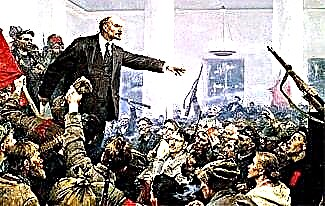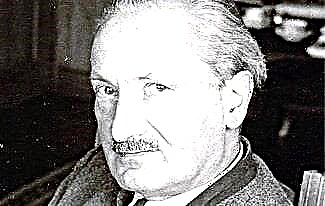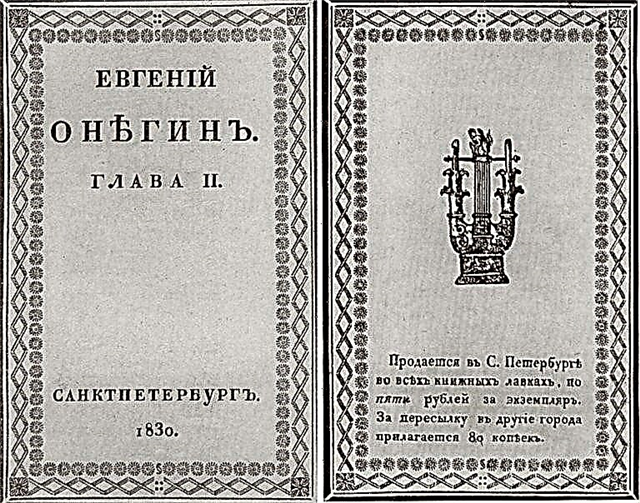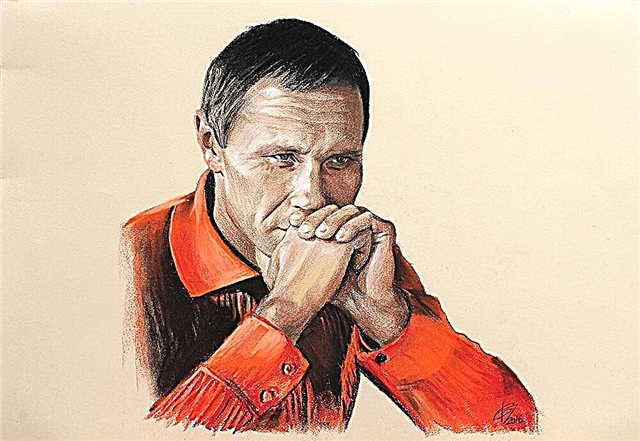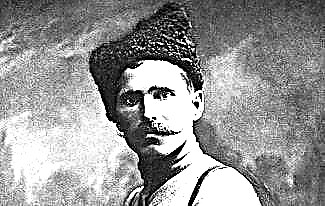Hermann Wilhelm Goering (1893-1946) - political, statesman and military leader of Nazi Germany, Reich Minister of Aviation, Reichsmarshal of the Greater German Reich, Obergruppenführer SA, Honorary SS Obergruppenführer, General of the Infantry and General of the Land Police.
He played a key role in the formation of the Luftwaffe - the German Air Force, which he led from 1939-1945.
Goering was one of the most influential figures in the Third Reich. In a June decree of 1941, he was officially referred to as "the successor to the Fuehrer."
By the end of the war, when the capture of the Reichstag was already inevitable, and the battle for power began in the Nazi elite, on April 23, 1945, by order of Hitler, Goering was stripped of all ranks and posts.

By the decision of the Nuremberg Tribunal, he was recognized as one of the key war criminals. Sentenced to death by hanging, however, on the eve of his execution, he managed to commit suicide.
There are many interesting facts in Goering's biography, which we will talk about in this article.
So, before you is a short biography of Hermann Goering.
Goering's biography
Hermann Goering was born on January 12, 1893 in the Bavarian city of Rosenheim. He grew up and was raised in the family of Governor-General Ernst Heinrich Goering, who was on friendly terms with Otto von Bismarck himself.
Hermann was the fourth of 5 children, from Heinrich's second wife, a peasant woman Franziska Tiefenbrunn.
Childhood and youth
The Goering family lived in the house of a wealthy Jewish doctor and entrepreneur, Hermann von Epenstein, Franziska's lover.
Since Hermann Goering's father reached great heights in the military field, the boy also became interested in military affairs.

When he was about 11 years old, his parents sent their son to a boarding school, where the strictest discipline was required from the students.
Soon the young man decided to escape from the educational institution. At home, he pretended to be sick until the moment when his father allowed him not to return to the boarding school. At that time, biographies, Goering was fond of war games, and also researched the legends of the Teutonic knights.
Later, Hermann was educated at cadet schools in Karlsruhe and Berlin, where he graduated with honors from the Lichterfelde military academy. In 1912, the guy was assigned to an infantry regiment, in which he rose to the rank of lieutenant a couple of years later.
At the beginning of the First World War (1914-1918), Goering fought on the Western Front. Soon he applied for a transfer to the German Air Force, as a result of which he was assigned to the 25th Aviation Detachment.
Initially, Herman flew airplanes as a reconnaissance pilot, but after a few months he was put on a fighter. He proved himself to be a highly skilled and brave pilot who shot down many enemy aircraft. During his service, the German ace destroyed 22 enemy aircraft, for which he was awarded the Iron Cross of the 1st and 2nd class.
Goering ended the war with the rank of captain. As a first-class pilot, he was repeatedly invited to participate in demonstration flights in the Scandinavian countries. In 1922, the guy entered the University of Munich at the department of political science.
Political activity
At the end of 1922, a significant event took place in the biography of Hermann Goering. He met Adolf Hitler, after which he joined the Nazi party.
A couple of months later, Hitler appointed the pilot as commander-in-chief of the Assault Detachments (SA). Soon Herman took part in the famous Beer Putsch, the participants of which sought to make a coup.
As a result, the putsch was brutally suppressed, and many Nazis were arrested, including Hitler. An interesting fact is that during the suppression of the uprising, Goering received two bullet wounds in his right leg. One of the bullets hit the groin and infected.

Companions dragged Herman to one of the houses, the owner of which was the Jew Robert Ballin. He bandaged the wounds of a bleeding Nazi and also provided him with refuge. Later, Goering, as a token of gratitude, will release Robert and his wife from the concentration camp.
At that time, the biography of the man was forced to hide from arrest abroad. He was tormented by severe pains, as a result of which he began to use morphine, which in turn negatively affected his psyche.
Hermann Goering returned home after the announcement of the amnesty in 1927, continuing to work in the aviation industry. At the time, the Nazi Party had relatively little compatriot support, taking just 12 out of 491 seats in the Reichstag. Goering was elected to represent Bavaria.
Against the background of the economic crisis, the Germans were dissatisfied with the work of the current government. Largely due to this, in 1932 many people voted for the Nazis in the elections, which is why they received 230 seats in parliament.
In the summer of the same year, Hermann Goering was elected chairman of the Reichstag. He held this post until 1945. On February 27, 1933, the infamous arson of the Reichstag took place, allegedly set on fire by the communists. The Nazi ordered the immediate crackdown on the communists, calling for their arrest or execution on the spot.
In 1933, when Hitler had already assumed the post of German Chancellor, Goering became Minister of the Interior of Prussia and Reich Commissioner for Aviation. In the same year, he founded the secret police - the Gestapo, and was also promoted from captain to general of the infantry.
In mid-1934, a man ordered the elimination of 85 SA fighters who participated in the coup attempt. The illegal shootings took place during the so-called "Night of the Long Knives", which lasted from June 30 to July 2.
By that time, fascist Germany, despite the Versailles Treaty, began active militarization. In particular, Herman was secretly involved in the revival of German aviation - the Luftwaffe. In 1939, Hitler openly declared that military aircraft and other heavy equipment were being built in his country.
Goering was appointed Minister of Aviation of the Third Reich. Soon the large state concern "Hermann Goering Werke" was launched, in whose possession many factories and factories confiscated from Jews were found.

In 1938, Herman was promoted to Field Marshal of Aviation. In the same year, he played an important role in the annexation (Anschluss) of Austria to Germany. With each passing month, Hitler, together with his henchmen, gained more and more influence on the world stage.
Many European countries turned a blind eye to the fact that Germany openly violated the provisions of the Treaty of Versailles. As time will show, this will soon lead to catastrophic consequences and actually to the Second World War (1939-1945).
The Second World War
The bloodiest war in human history began on September 1, 1939, when the Nazis attacked Poland. On the same day, the Fuehrer appointed Goering as his successor.
A few weeks later, Hermann Goering was awarded the Knightly Order of the Iron Cross. He received this honorary award as a result of the excellently conducted Polish campaign, in which the Luftwaffe played a key role. An interesting fact is that no one in Germany had such an award.
Especially for him, a new rank of Reichsmarshal was introduced, thanks to which he became the highest-ranking soldier in the country until the end of the war.
German aircraft demonstrated fantastic power before the operation in Great Britain, which bravely withstood the hardest Nazi bombing. And soon the initial superiority of Germany over the Soviet Air Force and completely disappeared.

By that time, Goering had signed a “final decision” document, according to which about 20 million Jews were exterminated. It is curious that back in 1942 the head of the Luftwaffe shared with Hitler's personal architect, Albert Speer, that he did not rule out the loss of the Germans in the war.
Moreover, the man admitted that it would be a great success for Germany simply to preserve its borders, not to mention victory.
In 1943, the Reichsmarschall's reputation was shaken. The Luftwaffe was increasingly losing air battles with the enemy, and suffered from personnel losses. And although the Fuehrer did not remove Hermann from his post, he was less and less admitted to the conference.
When Goering began to lose confidence in Hitler, he began to spend more time in his luxurious residences. It is worth noting that he was a connoisseur of art, as a result of which he collected a large collection of paintings, antiques, jewelry and other valuable things.
Meanwhile, Germany was getting closer and closer to its collapse. The German army was defeated on almost all fronts. On April 23, 1945, Goering, after a conversation with his comrades-in-arms, turned to the Fuehrer on the radio, asking him to take power into his own hands, since Hitler had resigned from himself.
Immediately after that, Hermann Goering heard Hitler's refusal to comply with his request. Moreover, the Fuhrer stripped him of all titles and awards, and also ordered the arrest of the Reichsmarshal.
Martin Bormann announced on the radio that Goering had been suspended for health reasons. In his will, Adolf Hitler announced the expulsion of Hermann from the party and the cancellation of the order to appoint him as his successor.
The Nazi was released from prison 4 days before the capture of Berlin by the Soviet army. On May 6, 1945, the former Reichsmarschall surrendered to the Americans.
Personal life
At the beginning of 1922 Goering met Karin von Kantsov, who agreed to leave her husband for him. By that time, she already had a young son.
Initially, the couple lived in Bavaria, after which they settled in Munich. When Herman became addicted to morphine, he had to be placed in a mental hospital. An interesting fact is that he showed such strong aggression that the doctors ordered to keep the patient in a straitjacket.

Together with Karin Göring lived for about 9 years, until the death of his wife in the fall of 1931. After that, the pilot met the actress Emmy Sonnenmann, who married him in 1935. Later, the couple had a girl named Edda.
An interesting fact is that their wedding was attended by Adolf Hitler, who was a witness from the groom's side.
Nuremberg trials and death
Goering was the second most important Nazi official to be tried at Nuremberg. He was charged with a number of serious crimes against humanity.
At the trial, Herman denied all accusations against him, skillfully evading any attacks in his direction. However, when evidence was presented in the form of photos and videos of various Nazi atrocities, the judges sentenced the German to death by hanging.
Goering demanded to be shot, since death on the gallows was considered shameful for a soldier. However, the court denied his request.
On the eve of the execution, the fascist was kept in solitary confinement. On the night of October 15, 1946, Hermann Goering committed suicide by biting through a cyanide capsule. His biographers still do not know how he got the poison capsule. The body of one of the biggest criminals in human history was cremated, after which the ashes were scattered on the banks of the Isar River.
Goering Photos











